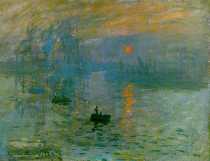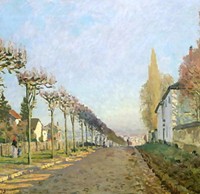|
|
Sixth Impressionist Exhibition (1881)
The sixth exhibition of the group, in April 1881, simply shows that the
dispersal of the group has been increased. Caillebotte, having tried in
vain to reassemble all those who really contributed to the birth of Impressionism,
has withdrawn in his turn. The exhibition, which takes place in the same
premises of Nadar's in the Boulevard des Capucines where the first was
held in 1874, only comprises Pissarro, Guillaumin, Gauguin, Vignon, several
studies by Degas, works by Berthe Morisot and Mary
Cassatt, and has an intimate character. Monet, Renoir and Sisley have
rejoined Manet at the Salon.
The economic situation having improved somewhat, Durand-Ruel resumes his
purchases and even begins to make small monthly stipends to his artists.
Thus they are finally able to work in peace and travel a little. In this
way Renoir goes to Algiers then to the south of Italy, to Palermo where
he paints a portrait of Wagner in a few minutes, then Naples, Porrtpeii
and Rome, where he discovers Raphael.
On his return he stops at L'Estaque to see Cezanne. But his ideas have
evolved in such a way that he is to move away from Impressionism. Manet,
on the contrary, seriously ill and ordered by his doctors to stay in the
country, finds a refuge in Impressionism. First he is at Belleville, then
at Versailles. He paints the garden with lights playing on the banks of
flowers, the masses of foliage, with lively and animated brush-work, simple,
happy works in which he puts the whole of his love of life.
From the end of 1881 Caillebotte has resumed his efforts to gather his
friends together again and restore its original character to the exhibitions
of the group. Durand-Ruel is present and offers to take charge of all
the business side. After protracted negotiations which result in the departure
of Degas, followed by Mary Cassatt, agreement is reached on a limited
group which, in the absence of Cezanne, is made up of Monet, Sisley, Pissarro
and Morisot, with Guillaumin, Caillebotte, Gauguin and Vignon added.
Seventh Impressionist Exhibition (1882):
The Death of Edouard Manet
The seventh exhibition, opened 1 March
1882 in rented rooms at 251 Rue Saint-Honore, is thus the most homogeneous
ever produced. Monet shows thirty landscapes, including "Debacles,"
and still-lifes; Renoir the "Luncheon
of the Boating Party," which signals the conclusion of his Parisian
period; Pissarro shows country scenes; Sisley has perhaps the most important
with his river and canal banks. The prices asked by Durand-Ruel are high.
But even though Impressionism is no longer discussed, buyers are rare
and it becomes necessary gradually to open the American market to translate
moral success into cash. Durand-Ruel works on this with the unstinted
help of Mary Cassatt, and a big exhibition is opened in New York in 1886.
At the Salon of 1882 Manet exhibits "Bal
aux Folies-Bergere," a large masterful canvas which synthesises,
not without some melancholy, the charm of Montmartre life of which the
painter was for so long a part. Now he is immobilised at his home, visited
by beautiful women friends whose portraits he paints in charming pastels.
At the beginning of 1883 gangrene reaches one of his paralysed limbs and,
despite amputation of the leg, he dies on 30 April.
At the end of the year a big Manet exhibition
is organised by Berthe Morisot and her husband, with a preface by Zola.
His studio is sold at auction in February 1884 for a high price. The disappearance
of Manet was felt by all as a great sorrow, an irreparable loss. Paradoxically
his death marks the effective break-up of the group whose exhibitions
he had followed so fondly without ever having been persuaded to take part
in them. But even if he did hold himself aloof, he must nevertheless be
considered the initiator, the one who was able to understand and master
the most diverse propositions by putting himself on a friendly, spiritual
and usefully critical level. In the last ten years of his life he seems
even to have done everything to re-enter the ranks of the Impressionists
and to suppress his superior personality. He is the least dogmatic, and
in his art the most free, spontaneous and young, just one among the others
without the least pretension to preaching. He accepts without fuss the
few official honours that come to him too late, a decoration, a little
respect, and he contemplates past battles with equanimity.
An eighth and final Impressionist exhibition
is held in Paris in 1886. In his review of the show, the French art critic
Felix Feneon (1861-1944) invents
the name "Neo-Impressionism" to describe the pointillist pictures
of Georges Seurat and others.
NEXT: (9) The
Impressionist Group Splits.
For details of the Impressionist Exhibition
in Boston (1883), and the even larger Impressionist Show in New York (1886),
both organized by the Parisian dealer Paul Durand-Ruel, please see: American
Impressionism (c.1880-1900).
Acknowledgements:
We gratefully acknowledge the use of an excerpt from Impressionism,
by Jacques Lassaigne (1966).
|


